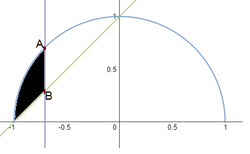Integration
Integration is the process of evaluating integrals. It is one of the two central ideas of calculus and is the inverse of the other central idea of calculus, differentiation. Generally, we can speak of integration in two different contexts: the indefinite integral, which is the anti-derivative of a given function; and the definite integral, which we use to calculate the area under a curve.
Note that many integration problems will require the use of integration techniques.
Contents
Notations in Indefinite Integrals
Let and be functions related in such a way that
- The integral sign denotes integration.
- is called the indefinite integral of with respect to .
- is called the integrand.
- The differential is part of the integrand; it identifies the variable used in integration.
- is called the general anti-derivative of .
- is called the constant of integration; it is an arbitrary constant.
- If has a specific value from given conditions, is called a particular antiderivative.
Evaluating Indefinite Integrals
What is the anti-derivative of
Expanding the expression gives . Applying the reverse power rule for we have
where is the constant of integration. Note that
What is the indefinite integral of
Let , then differentiating with respect to gives , so . Thus,
where is the constant of integration.
What is the anti-derivative of
Let , then . Remember that
Back to the function ,
The integral now becomes
Integrating by parts, we let and let Then
where is the constant of integration.
Definite Integrals
Evaluate
From the previous example, we have
Setting the upper and lower limits to be and , respectively, the integral is evaluates to
Evaluate the integral
From the earlier example, the indefinite integral of is given to be
Applying the limits, we have
Integration Techniques
Main Article: Integration by Parts and Integration with Partial Fractions
Find the anti-derivative of .
We should integrate by parts.
Using the LIATE (Logarithm, Inverse trigonometric, Algebraic, Trigonometric, Exponential) rules, we have Hence,
where is the constant of integration.
Find the anti-derivative of
By partial fraction decomposition, we have
Recall that the anti-derivative of is simply , so the anti-derivative of the expression in question is
where is the constant of integration.
Problem Solving - Basic
Give your answer to 3 decimal places.
Verify by integration that the area of a circle with radius is .
By coordinate geometry, let the circle of radius have its center at the origin, then the circle satisfies the equation .
Rearranging gives . We want to integrate from to to get the area of the semicircle:
Let , then Here, to ranges from to Then, the integral becomes
The integral of can be found via the half-angle substitution. Thus, the area of the circle is
 The figure at right shows a unit semicircle (in blue) and the graph of (in green).
The figure at right shows a unit semicircle (in blue) and the graph of (in green).
Let the purple line segment be the longest vertical line segment that joins the blue semicircle and green line in the domain
If is the area of the black shaded region, what is
Problem Solving - Intermediate
Evaluate the definite integral The answer must be a decimal in terms of . For example, if the calculation result is then the answer should be .